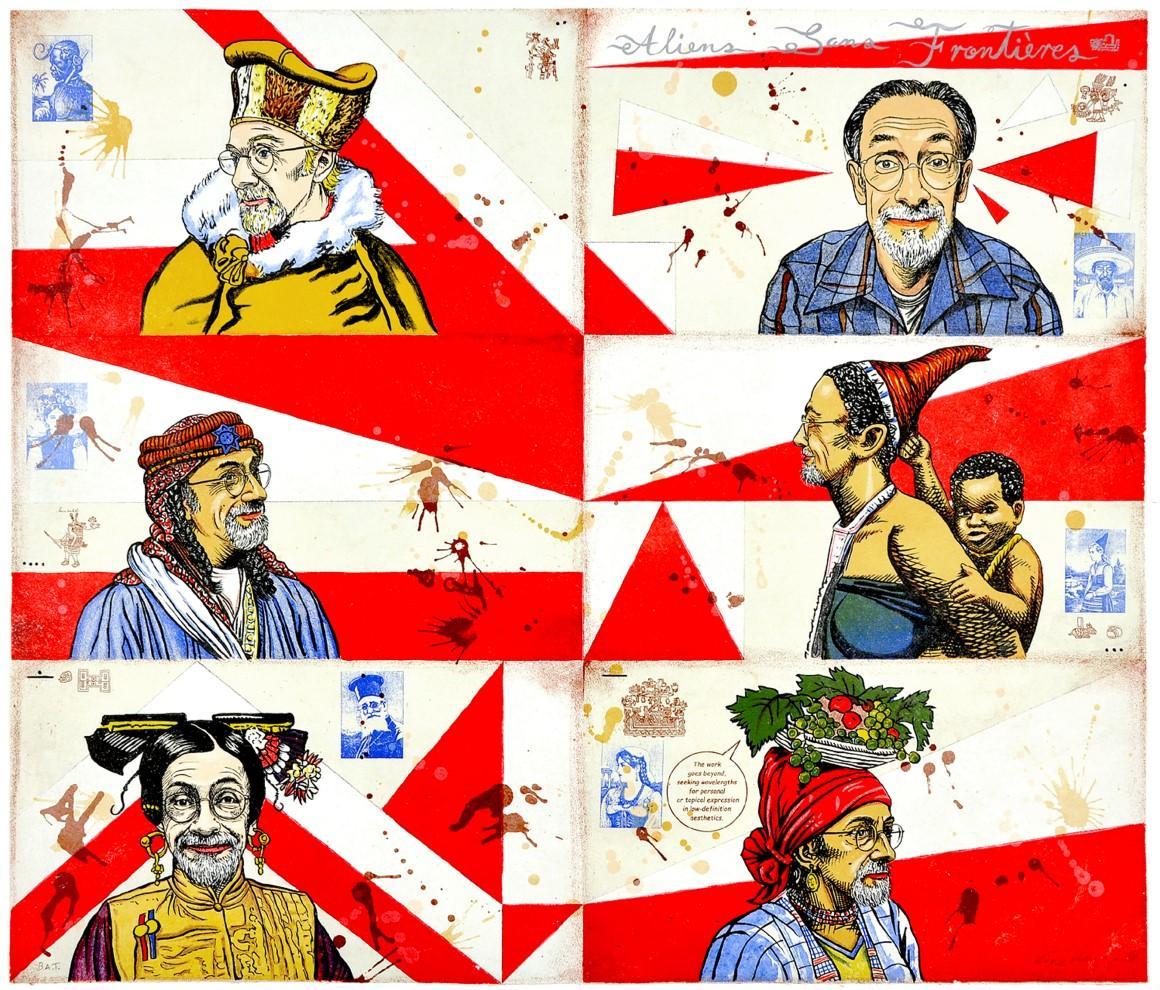Enrique Chagoya
The Ghosts of Borderlandia
The imagery in this codex refers to the borders that people build between themselves. In The Ghosts of Borderlandia, people’s eyes are hidden behind a wall or underground to symbolize the lack of sight that borders create. The invisible borders create stereotypes that dehumanize the “other” and creates an “us vs. them” context. There are physical and invisible borders. They may be between social classes, genders, religions, ethnicities and cultures. Viewers may discover some recognizable artists and stereotypical characters in front and behind the wall.
 Ghosts of Borderlandia, 2017
Ghosts of Borderlandia, 2017
Color lithograph with chine collé; Ed. 30
15" x 80"
Courtesy of the Artist
Aliens Sans Frontières
In this codex I have made multiple self-portraits as male and female ethnic stereotypes portraying African, European, Mexican, Brazilian, Asian and Middle Eastern characters. I use my own face in the portraits to show that under any ethnic stereotype is an individual and that we are all from the same species. I do this with some sense of humor but without trivializing the seriousness of the subject. I recently had my DNA ancestry researched and I learned that I have genes from Native American (from Central Mexico), European, Ashkenazi, Middle Eastern/North African, Sub Sahara African, and East and South Asian ancestors. This may be a partial self-portrait of my genetic makeup within my DNA.
Just as our DNA might be mixed, we could have a civil war in our blood if our genes did not get along with each other. But they do get along, they make us. I think that our differences enrich our lives. The more genetic diversity we have, the better our chance for survival… Just as our different genes originate from different parts of the world inhabiting our bodies peacefully without an internal civil war, I wonder if we as humans someday can do the same–live in peace with each other, celebrating our differences rather than being afraid of each other. Needless to say, this would require economic fairness, and a more sustainable relationship with our planet’s life and natural resources. This is an urgent change that may happen out of necessity not out of ideologies. The other option is self-extinction.
I don’t want to be didactic with my imagery at all. My art just helps me to exorcise my anxieties in my best possible creative mood, and I feel lucky to have the context in which my freedom is expressed. We don’t change the world with art, but art may help us to think and dream a little bit about positive changes in real life.
 Aliens Sans Frontières, 2016
Aliens Sans Frontières, 2016
Color lithograph on handmade Amate paper; Ed. 30
24" x 28"
Courtesy of the Artist
About the Artist
Enrique Chagoya juxtaposes secular, popular and religious symbols in his work to address the ongoing clash between cultures. He uses humor and familiar icons to create deceptively friendly points of entry for the discussion of complex issues.
Chagoya was born and raised in Mexico City. His father, a bank employee by day and artist by night, encouraged his interest in art by teaching Chagoya color theory and how to sketch at a very early age. As a young adult, Chagoya enrolled in the Universidad Nacional Autónoma de México, where he studied political economy and contributed political cartoons to union newsletters. He relocated to Veracruz and directed a team focused on rural-development projects, a time he describes as “an incredible growing experience…[that] made me form strong views on what was happening outside in the world.” This growing political awareness would later surface in Chagoya’s art. At age 26, Chagoya moved to Berkeley, California and began working as a free-lance illustrator and graphic designer. He enrolled in the San Francisco Art Institute, where he earned a BFA in printmaking in 1984. He then pursued his MA and MFA at the University of California, Berkeley, graduating in 1987. He moved to San Francisco in 1995. Chagoya has been exhibiting his work nationally and internationally for decades. A mid-career retrospective of his work was organized by the Des Moines Art Center, Iowa in 2007, which travelled to the Berkeley Art Museum and the Palm Springs Art Museum, California. In 2014, a survey of his work was organized by Artium in Vitoria, Spain.
Enrique Chagoya is currently Full Professor at Stanford University’s department of Art and Art History and his work can be found in many public collections including the Museum of Modern Art, New York; The Metropolitan Museum; Whitney Museum of American Art; San Francisco Museum of Modern Art; Art Institute of Chicago; Smithsonian Museum of American Art, Washington D.C.; and the Centro Cultural de Arte Contemporaneo, Mexico City, Mexico, among others. He has been recipient of numerous awards including two NEA artists fellowships, one more from the National Academy of Arts and Letters in New York, residencies at Giverny and Cite Internationale des Arts in France, and a Tiffany fellowship. Chagoya is represented by Anglim Trimble Gallery, San Francisco; George Adams Gallery, New York; and Lisa Sette Gallery, Scottsdale, AZ. His prints are published by Shark’s Ink, Lyons, Co; Electric Works, San Francisco, CA; Magnolia Editions, Oakland, CA; ULAE Bay Shore, NY; Segura Publishing, Pueblo, AZ; Trillium press, Brisbane, CA; Made in California, Oakland, CA; and Smith Andersen Editions, Palo Alto, CA.